
VW Arteon Shooting Brake review 2022

Introduction
If you're in the market for a trendy, stylish upmarket estate car, ask yourself if your badge snobbery is enough to stop you from leasing a Volkswagen.
If it is, it shouldn't be – especially as this might be your final opportunity to get your hands on the vehicle in question: the Arteon Shooting Brake.
If you remember the CC, which was effectively a coupe-shaped VW Passat, think along the lines of similar stylishness and add a big bottom onto it.
That is what a Shooting Brake is nowadays. Instead of a boxy-style estate, Shooting Brakes tend to have a more bulbous shape to them, and the Arteon is no exception.
Indeed, it looks stunning.
Select's rating score* - 3.9 / 5
At A Glance
The Arteon features a heavily revised grille which modernises the traditional VW front end, adding an LED light strip across its width on some versions. They link up with LED strips that make up the sidelights, while a more prominent lower grille now takes centre stage.
Beneath the lower grille, the bodywork is sculpted to create two wing-like shapes, while the gaps they leave make space for an air intake at each side.
Around the sides, the large alloys take centre stage, aided by shapely side skirts and a sloping roofline which screams performance. This image is helped further by the roof spoiler, which sits above the rear window.
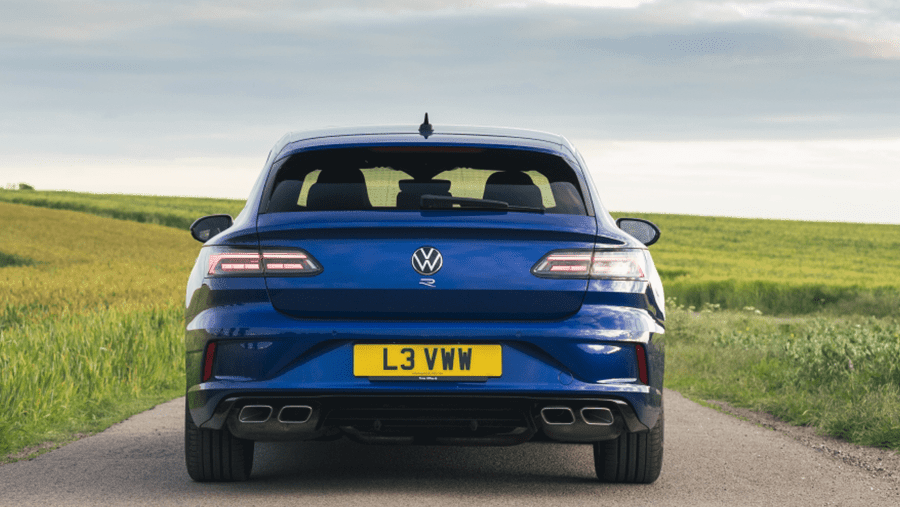
From the back, if you cover the upper half from view with your hand, you’d swear it was the hatchback version. Why? The rear spoiler follows the same outline as the top of its boot lid.
But removing your hand to reveal all brings the elongated boot into view, a steeply angled rear window, and the bulbous form.
The car is utterly stunning and arguably the best-looking VW on the market today.
It is a shame, then, that VW is rumoured to be killing off the Arteon, replacing it with an all-electric car called the ID Aero.
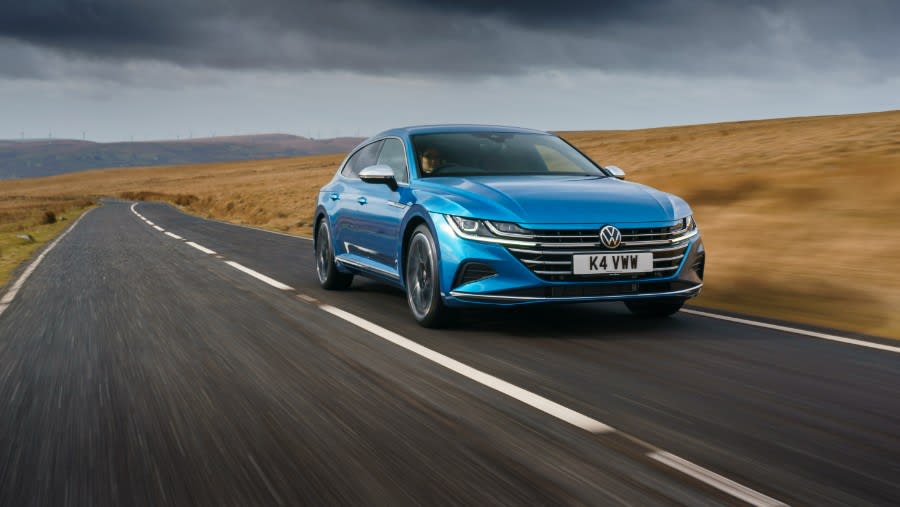
Key Features
Like the hatchback version, the Arteon Shooting Brake is available in three trims.
Entry-level Elegance comes with 18-inch alloys, an eight-inch infotainment touchscreen with SatNav, a DAB radio, Apple CarPlay, and Android Auto. You also get a 10.25-inch digital cockpit display, heated front sports comfort seats, a sports steering wheel, and keyless entry and start.
On top of that, there are LED headlights, dynamic indicators, a rear-view camera, stainless steel pedals, three-zone climate control and six-way electric driver’s seat adjustment.
The R-Line grade adds 19-inch alloys, privacy glass at the rear, a panoramic sunroof with tilt and slide, plus 30-colour interior ambient lighting. The vehicle also boasts some sportier styling elements. However, curiously, although it’s marketed as the mid-range trim, it loses a couple of features from Elegance, such as the rear-view camera, and is slightly cheaper.
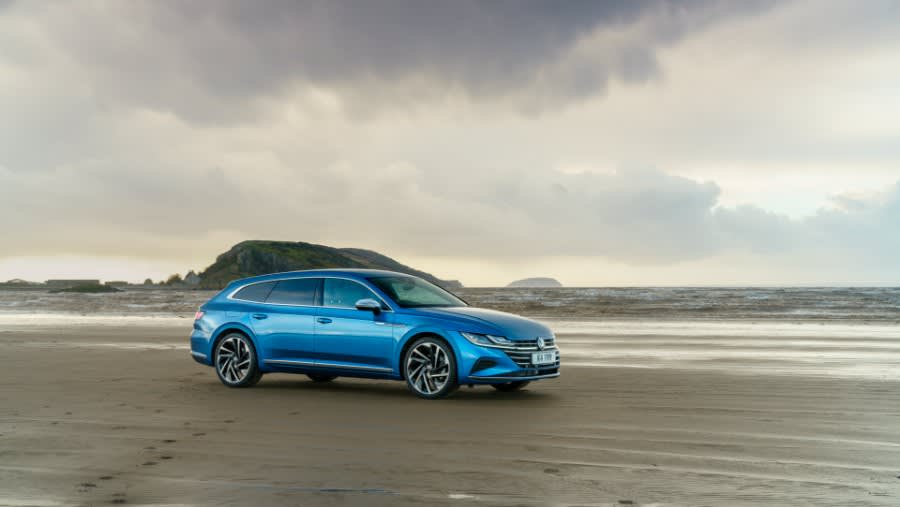
The flagship R model gets 19-inch black alloys, the R styling pack with sporty bumpers and side sills, sports seats, a heated leather sports steering wheel, black carbon interior décor and blue brake callipers.
In terms of powertrains, there are three to select from.
The two petrols, called TSI, are a front-wheel drive 150PS 1.5-litre setup with a six-speed manual or a 190PS 2.0-litre with a seven-speed DSG automatic.
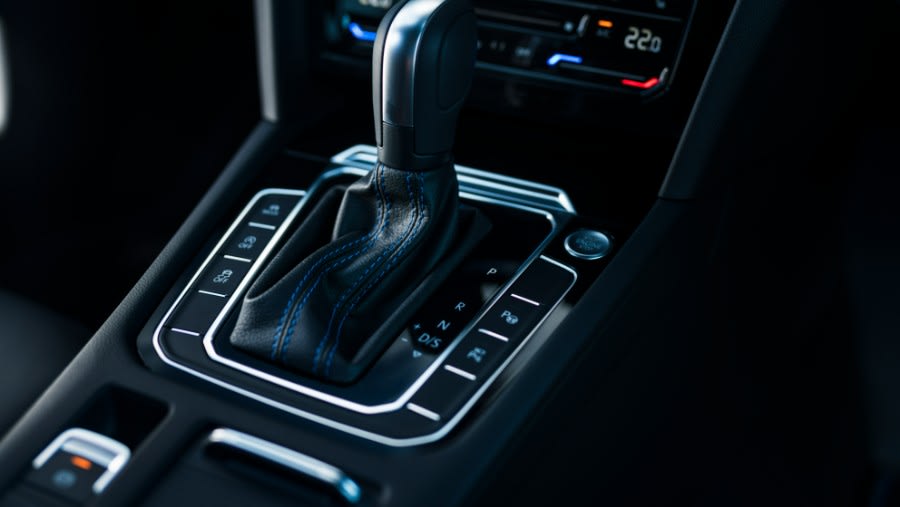
The two diesels, called TDI, are both 2.0-litres with automatic gearboxes, producing 150PS with front-wheel drive. Meanwhile, the high-powered 200PS variant is available with front-wheel drive or VW's 4Motion all-wheel drive system.
Not all combinations are obtainable with all trims, but the Elegance and R-Line can come with a plug-in variant: the 218PS turbocharged 1.4-litre TSI eHybrid. And that’s what we’re interested in today.
There is, of course, a special engine reserved just for the R version, which is still a 2.0-litre TSI petrol. But it produces 320PS with 4Motion all-wheel drive and the seven-speed automatic.
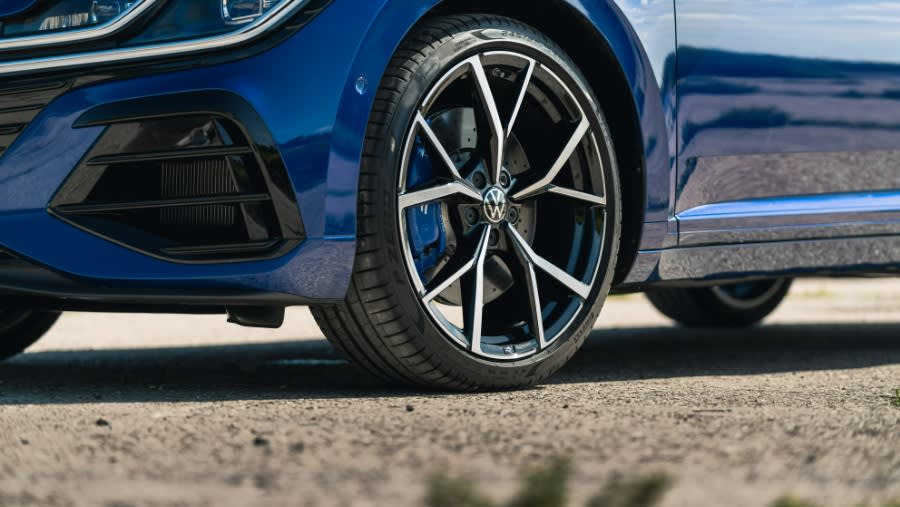
Range & Batteries
The eHybrid has a 10.4kWh battery.
According to Volkswagen, that gives the Arteon Shooting Brake an all-electric range of 35 miles. You can read more about EV range in our guide explaining electric car range.
In practice, though, expect less than this as range depends on several factors, including road conditions, ambient temperature and driving style.
Somewhere between 25 and 30 miles is more realistic.
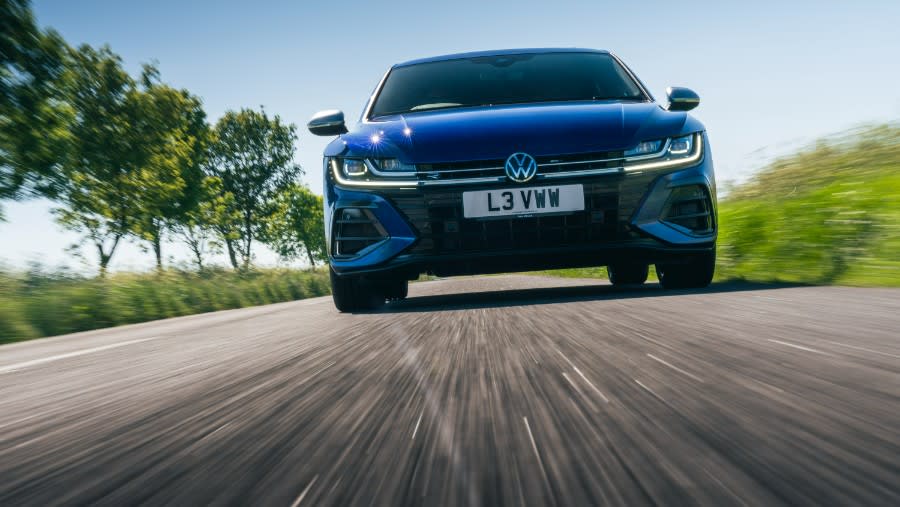
Performance & Drive
We took the eHybrid for a test drive in R-Line trim.
It may be just a 1.4-litre, but when combined with the electric motor, it’s enough to get it from 0-62mph in 7.8-seconds. That is 0.2-seconds quicker than the 190PS petrol auto.
It moves away keenly, with the electric motor helping to deliver an instant burst of torque, minimising the usual delayed response of an automatic ‘box.
There is a lot of performance across the rev range, and the powertrain seems well-engineered.
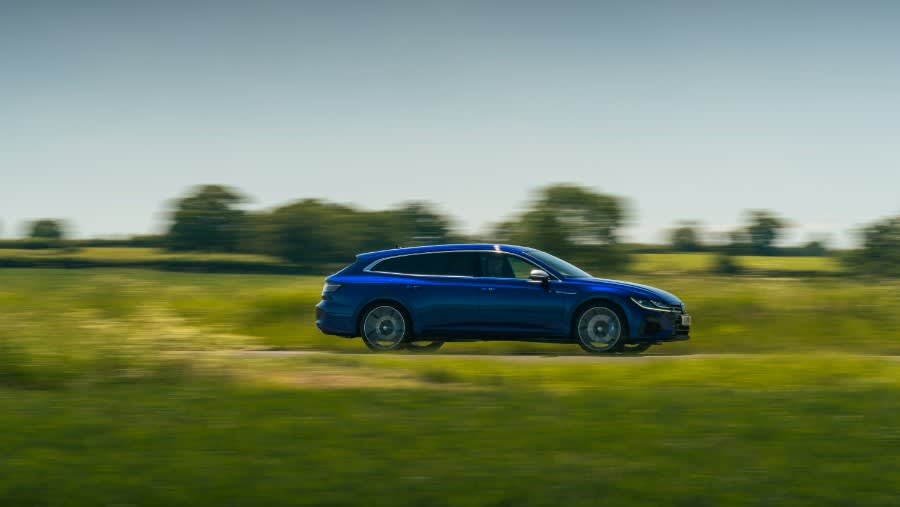
That said, all the other units in the range do, too – even the entry-level 1.5-litre 150PS engine, which is hardly slow. Although, given it's a reasonably big car, most will want a touch more grunt on their Arteon Shooting Brake.
As a result, the 2.0-litre TSI 190PS lump is the minimum we’d recommend, especially as its economy figures are barely worse than the 150PS engine.
If you're driving long distances or need some excellent engines for towing, the diesels also perform well, offering superior fuel economy and lower emissions.
If your heart is ruling your head, people with less inclination to be sensible might want to try out the ‘R’ version and enjoy the 320PS beneath the bonnet, with its below 5.0-second 0-62mph time.
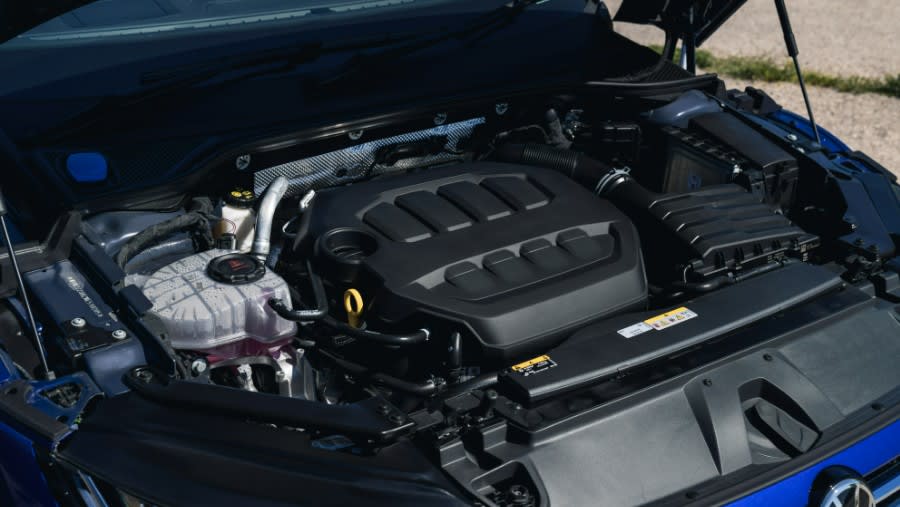
Our hybrid is excellent for those who need fuel economy. The six-speed DSG automatic changes smoothly, although it can be fidgety when driving at low speeds.
In terms of ride comfort, there are better examples of what the Arteon can do than what we're driving. Its extra weight and 19-inch wheels in the R-Line trim mean it’s less forgiving over bumps in the tarmac than the Elegance trim's 18-inch wheels.
This is a minor gripe, though, as the eHybrid isn’t uncomfortable by any means. And the others in the range offer a pleasing level of absorption from imperfections in the road surface.
Dynamic Chassis Control – basically VW’s name for adaptive suspension – means the car can adjust its setup depending on which driving mode you’re in. So you can effectively choose how comfortable you want it to be.
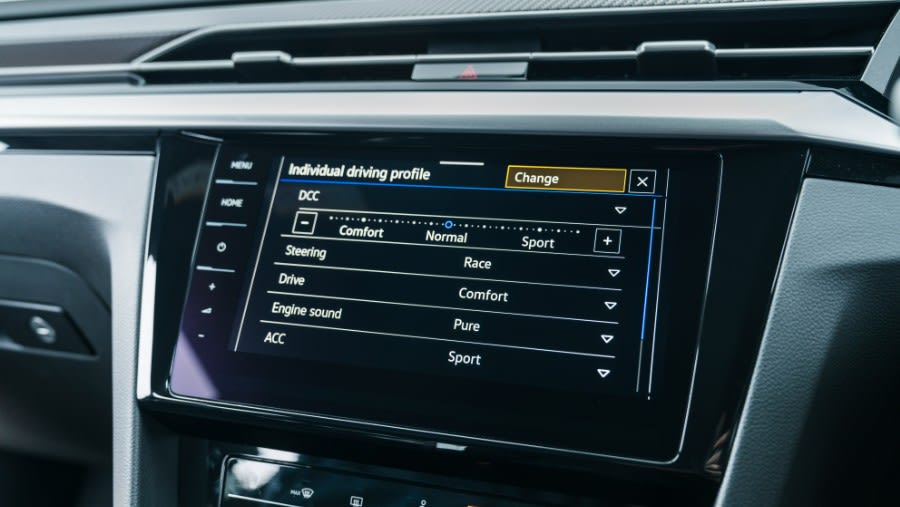
It is an optional extra, though, unless you pick the ‘R’ version, where it’s included as standard.
Because the VW Arteon is primarily geared up for comfort, a vehicle of this size inevitably rolls a bit in the bends.
Nevertheless, the car is well-engineered, with the excellent steering being light when it needs to be but weighting up nicely in faster corners, added to superb levels of grip. This all means you can have a bit of fun, even if it’s a far cry from a hot hatchback.
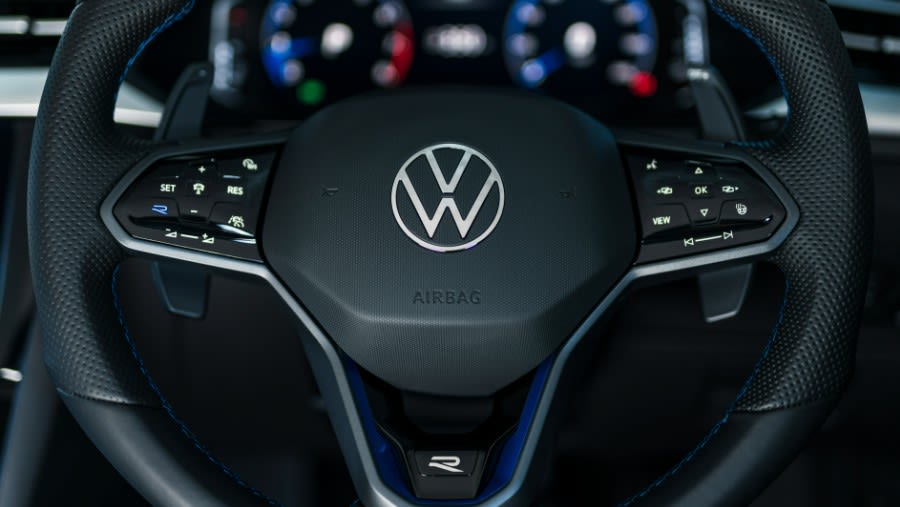
Charging
Charging up the eHybrid's batteries from 0-100 per cent takes just under three and three-quarter hours.
Maximum charging speed is only 3.6kW, so it'll take the same time if you use a 7kW home wall box or a high-speed public charging point. Need to get the most out of every charge? Consult our guide on picking your ideal electric car charger to find out more.
It may be slow compared with all-electric cars, but they have much bigger batteries.
Running Costs & Emissions
You will get a claimed 217.3mpg from the eHybrid in R-Line trim. It also produces just 30g/km of CO2, the most economical powertrain in the Arteon range.
This improves to 235.4mpg and 26g/km of CO2 if you select the Elegance trim.
Of course, achieving anywhere near these figures will require you to keep the battery charged.
For the petrols, the 1.5 TSI manages 42.2mpg, producing 151g/km of CO2, while the 2.0 TSI manages 38.7-40.4mpg and 158-165g/km of CO2, depending on trim.

The 2.0 TDI diesels fare slightly better, with the 150PS engine managing 55.4-58.9mpg (127-134g/km CO2) and the 200PS engine claiming 50.4mpg (146g/km CO2). But the latter’s figures drop to 46.3mpg and 159g/km CO2 with all-wheel drive.
Pick the 'R' version, and fuel economy dives to 30.7mpg from the 320PS engine, which emits 209g/km of CO2.
The biggest drawback with the eHybrid is the high price – even the non-hybrids are comparable with premium brand cars.
Regarding reliability, Volkswagen is okay, but there are more dependable brands to lease.
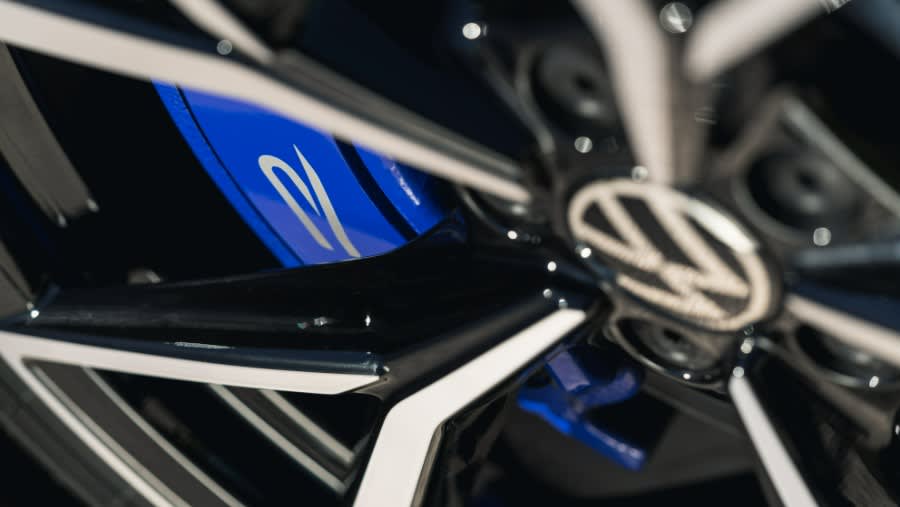
Interior & Technology
Inside, the Arteon looks smart. It is not overly luxurious, and if you're moving over from a BMW, Mercedes-Benz, or Audi, you might find it's a step-down. But it still looks the part.
The design is virtually identical to the sister car, the Passat, but don’t let that put you off.
There is plenty of silver trim to break up the dark colours of our R-Line test car. You get horizontal bars along the dashboard and around the outline of the spokes on the steering wheel, which is filled with gloss piano black plastic buttons.
Annoyingly, these are touch-sensitive buttons, so it’s easy to accidentally change settings while you’re simply holding the wheel.
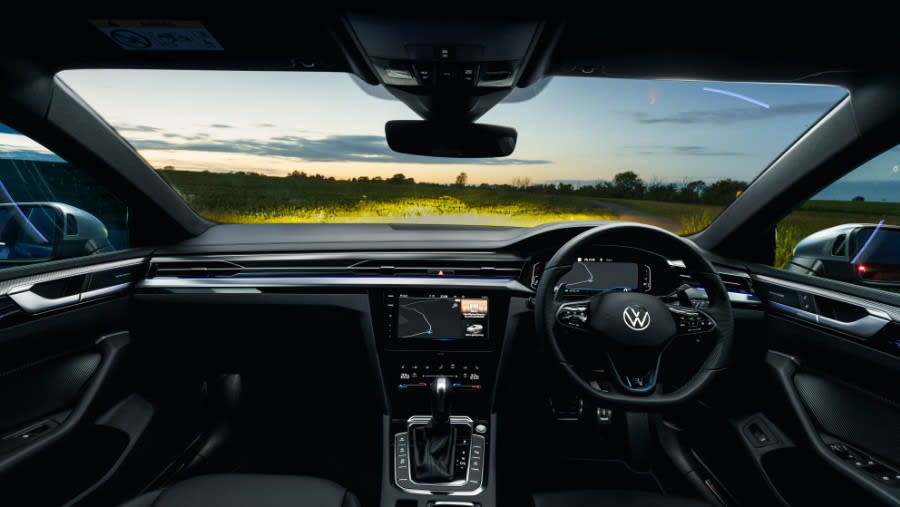
More switches surround the gear lever, while the infotainment screen is positioned within the dashboard, beneath the air vents.
Unfortunately, while some VWs feature a rotary dial to control the infotainment system, there isn’t one in the Arteon. This omission is surprising for a motor that’s trying to be upmarket.
As a result, you’ll need to touch the screen to operate it on the move, which isn’t convenient. Plus, you’ll need to look down, as it’s positioned lower than in many cars.
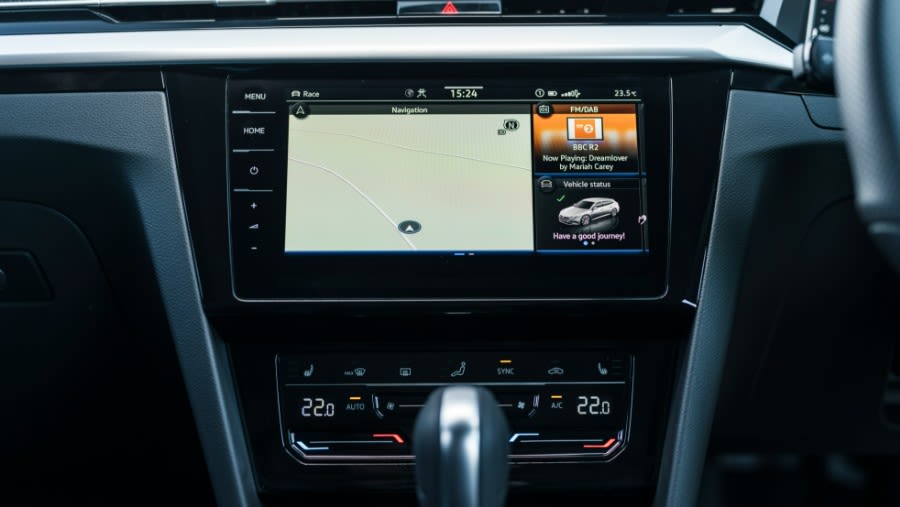
At least the infotainment system is a good one, though. It is responsive, and its menu layout is intuitive.
It is undoubtedly one of the better systems, although it doesn't match BMW's iDrive system.
If these systems are essential to you, you can upgrade to a larger 9.2-inch screen as an optional extra.
The touchscreen is complemented by Volkswagen's excellent Digital Cockpit display, which replaces traditional analogue instruments with a 10.25-inch screen.
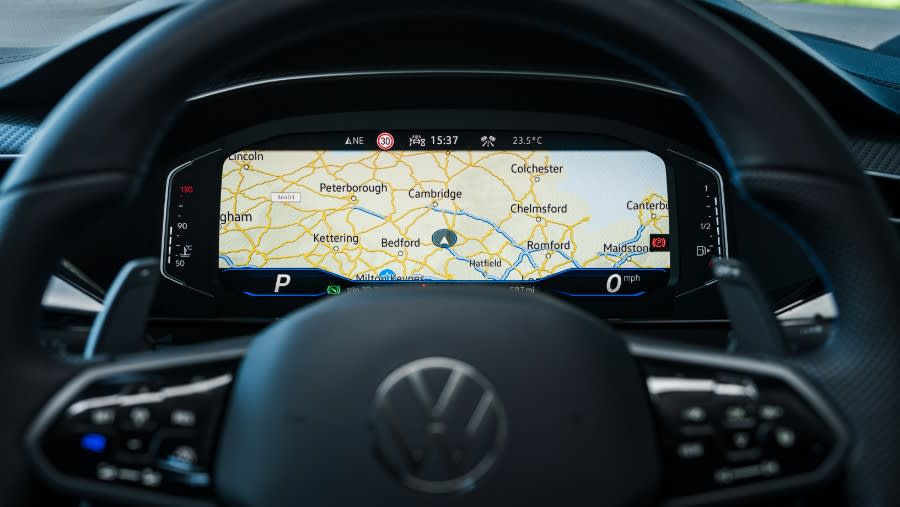
It is highly customisable, so you can choose which information you want to view, while an optional head-up display can also be added.
Overall, the interior quality is of a high standard.
It certainly feels solid and well-built, and although some may feel the looks are a tad conservative, it's, without a doubt, a very smart design.
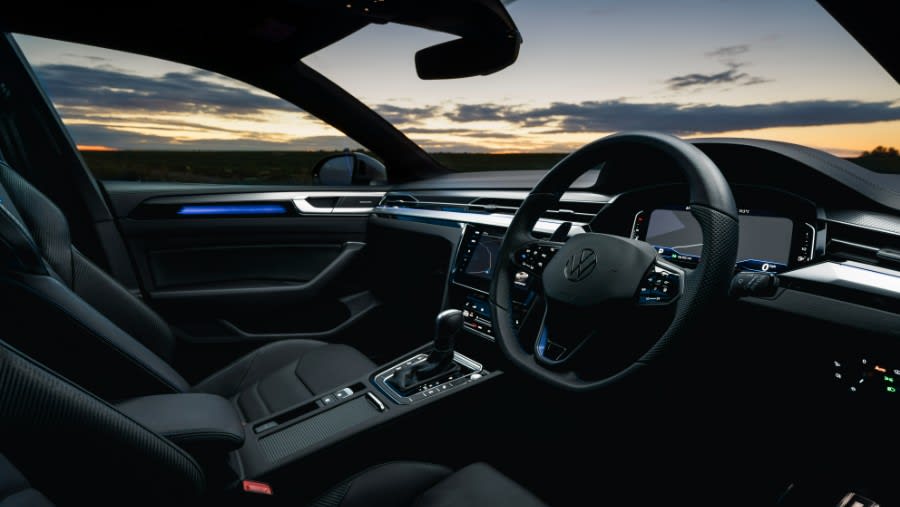
Practicality & Boot Space
You won’t struggle to find a comfortable driving position in the Arteon Shooting Brake, as the steering wheel has plenty of travel, and adjusting the seat is simple.
The lumbar adjustment is electrified, as is the back of the seats, although more electronic functions will cost you extra.
Nevertheless, the seats are absorbing, and the driving position is slightly raised, giving you good forward visibility, helped by reasonably thin front pillars.
Looking back, the rear visibility is compromised by significantly thicker pillars due to the roundedness of the car’s backside, influencing the diagonal angle of the rear window.
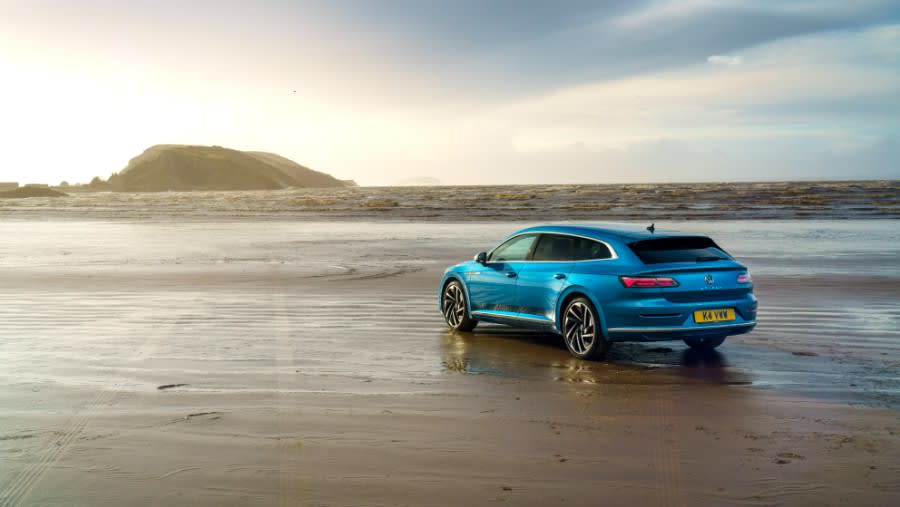
It shouldn't cause a massive problem because front and rear parking sensors are included as standard. However, a rear-view camera isn’t included on our R-Line test car but is on the entry-level Elegance.
In terms of spaciousness, you won’t have a problem at all.
There is a lot of head and legroom up front, with the Arteon more than matching most of its competitors, while the rear is arguably even more impressive.
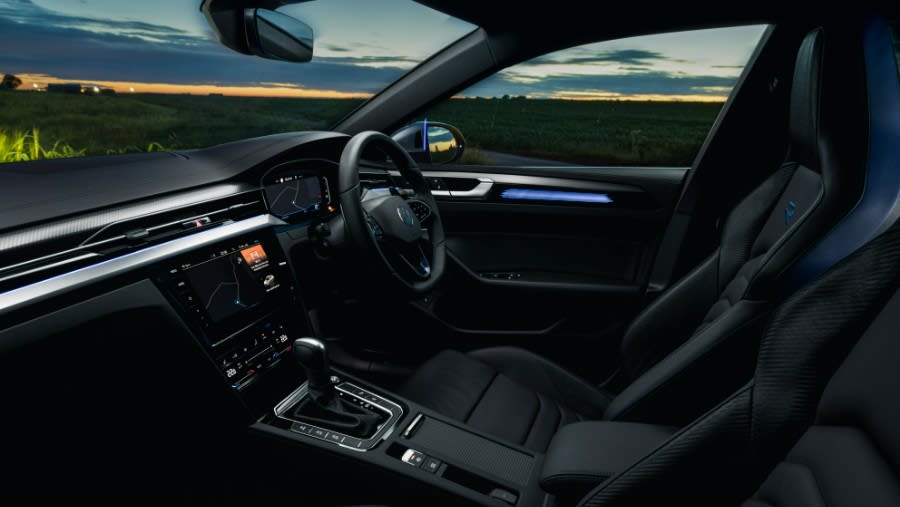
You lose a bit of headroom because of the sloping roofline. But the slope is slighter than in the hatchback, so headroom is marginally better in the Shooting Brake.
You are not short-changed in storage space either, with a deep cubby in the centre console, a generously sized glove compartment and large door bins.
Boot space measures 455 litres in our eHybrid test car, although you'll get 590 litres in the non-hybrid versions.
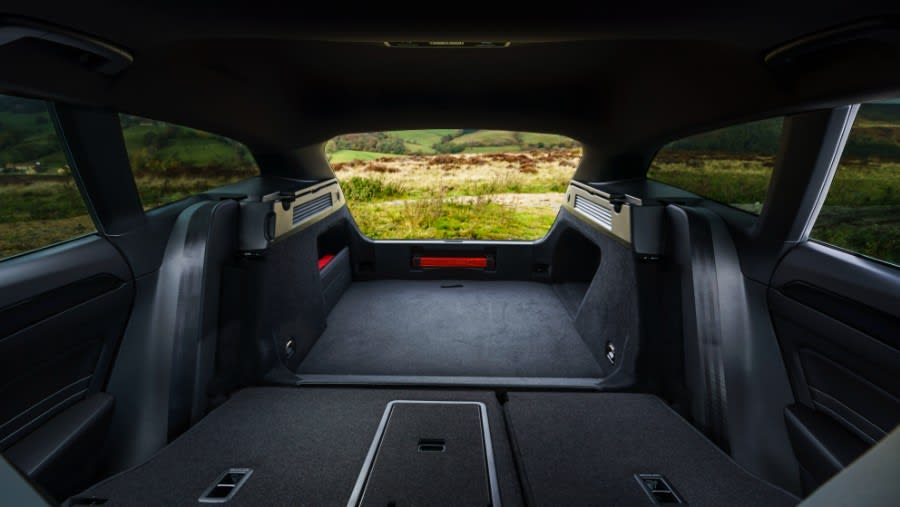
For some reason, VW hasn’t published a figure with the rear seats down, but we understand it’s around 1,600 litres in the non-hybrid.
The seats fold in a 60/40 split, but this is less versatile than the 40/20/40 configuration in some competitors.
Unfortunately, the boot floor isn’t adjustable, leaving a rather large boot lip, which isn’t convenient if you need to slide heavier, bulkier items in and out.
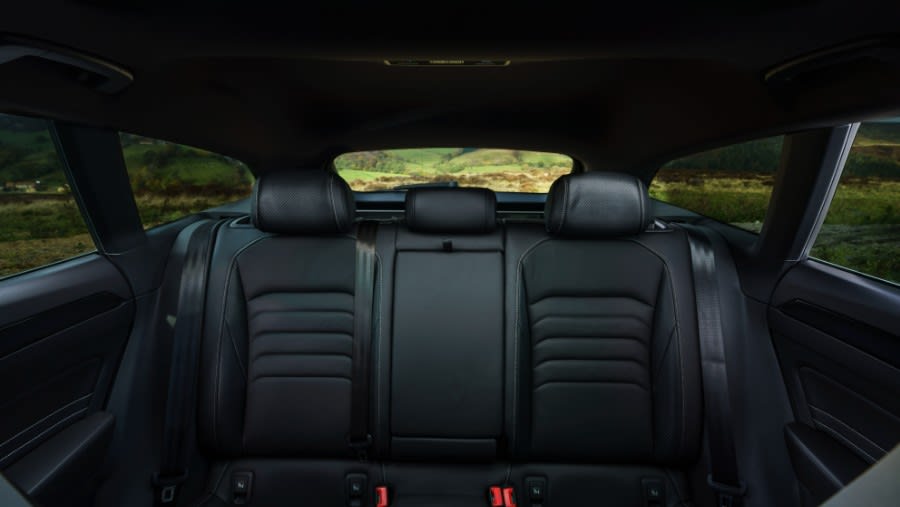
Safety
Crash-testing experts at Euro NCAP put the Arteon hatchback through its paces in 2017, although the rating is also valid for the Shooting Brake.
It was awarded a five-star rating, scoring 96 per cent for adult occupants, 85 per cent for children and 82 per cent for safety assists.
You get electronic stability control, autonomous emergency braking, adaptive cruise control, and driver fatigue detection alert. There is also traffic sign recognition, hill start assist, a front-facing camera, front and rear parking sensors, lane keeping assist and traffic jam assist.
The rear-view camera and lane change assist with rear cross-traffic alert are on Elegance, and R trims, but curiously, they’re optional extras on the R-Line.
The R trim also gets Dynamic Chassis Control, plus an electronic differential lock, which improves traction and handling.
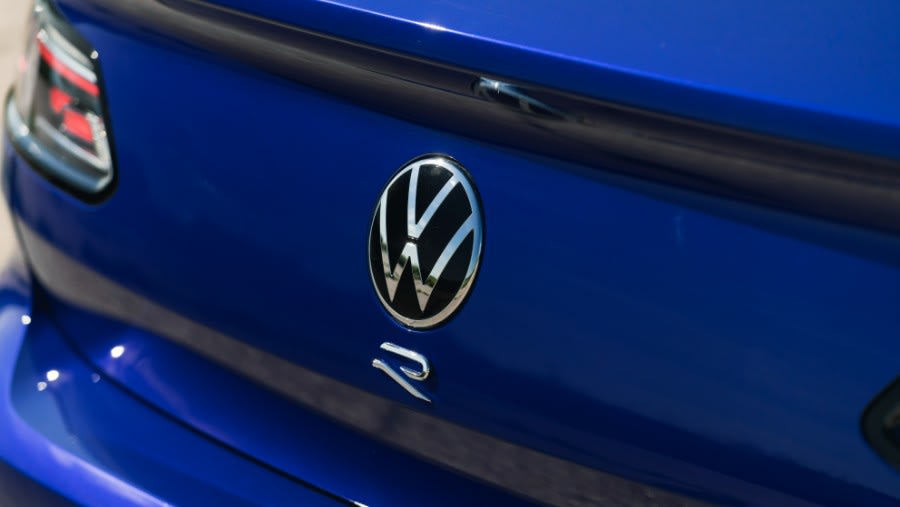
Options
A handful of paint jobs aside, there’s no shortage of items on the Arteon’s options list.
Each trim can upsize the alloys by an inch, and you can add a heated front windscreen for the winter if you want.
The Assistance Plus Pack adds Park Assist steering aid and, for the R-Line trim, includes lane change assist with rear-cross traffic alert. However, most of these features are available individually.
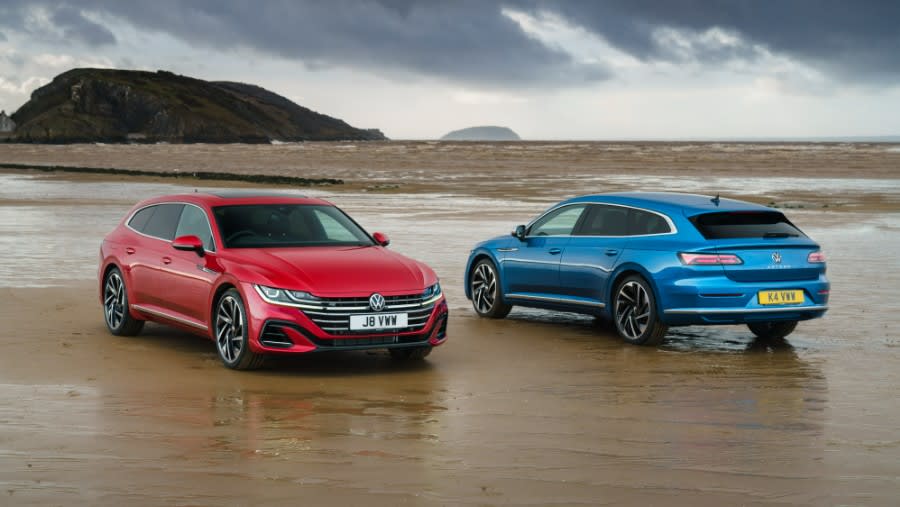
The Dynamic Chassis Control is also available, which can include Sports Suspension on the R-Line trim, while the head-up display is also on the list.
Leather upholstery and 12-way electric adjustable driver’s seats and massage function front seats are also available, along with accessories from roof rails and towbars to roof boxes and mudflaps.

Rival Cars
If you're specific about wanting a Shooting Brake, your leasing options are limited, as it's a rare shape not offered by many manufacturers.
The Mercedes-Benz CLA and CLS are two options, while the Kia Pro Ceed, Genesis G70 and Peugeot 308 SW and 508 SW offer alternatives.

If you don’t mind a regular estate car, your choice grows substantially, with rivals such as the Skoda Superb Estate, Audi A4 Avant and the BMW 3 Series Touring coming into play, along with the Volvo V60.
While Audi, BMW and Mercedes-Benz will offer you an even more refined driving experience, the VW Arteon trumps most opponents regarding practicality.
If you need more room than the Arteon offers, you could do worse than look at its sister car, the Passat Estate, which is also cheaper.

Verdict & Next Steps
The Volkswagen Arteon Shooting Brake is a superbly attractive car that offers excellent practicality without sacrificing much.
With reasonable handling, decent ride comfort, a nice interior, lots of standard equipment and well-refined engines, it’s a tempting leasing proposition.
The eHybrid is excellent if you're a company car user wanting to save on tax. But, if not, the extra cost of it might be unnecessary, given that diesel Arteons are frugal, too.
Those who want performance might like to try the ‘R’ version, but it’s significantly more expensive than the entry-level Elegance.
The Arteon Shooting Brake ticks lots of boxes. But, if you want to save money, the VW Passat Estate is even more practical and cheaper to lease. There is even an eHybrid variant of it too.
Where to next?
View our latest Volkswagen Arteon Shooting Brake Leasing Deals - from just £407.20 per month inc VAT**
Looking for a great leasing deal? Check out our incredible range of Special Offers
New small Estate? Read our latest Car Reviews and find the right model for you
Want to know more about leasing? Take a look at our comprehensive Leasing Guides
Interested in everything motoring? Why not catch up on all the latest Car Leasing News.
*Score based on Select’s unique meta score analysis, taking into account the UK’s top five leading independent car website reviews of the Volkswagen Arteon Shooting Brake
**Correct as of 17/11/2022. Based on 9 months initial payment, 5,000 miles over a 48 month lease. Initial payment equivalent to 9 monthly payments or £3,664.80 Ts and Cs apply. Credit is subject to status.






















